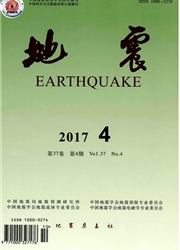

 中文摘要:
中文摘要:
对1900年以来新疆地区4次M≥7.7大震序列类型、发震构造与震源特征、大震孕震阶段地震活动图像的动态演化特征等进行了分析,探讨r几次大震震源特征。结果表明,大震序列类捌具有多样性,包括主-余型、双震型和孤立型;大震震源断错性质基本上反映了天山和阿尔泰构造带分别以逆冲和走滑为丰的构造运动特性;大震孕震阶段地震活动图像演化特征明显,中长期阶段新疆地区6级地震活跃,中期阶段相对平静,短期阶段有差异,大震后新疆处于旺著平静状态;不同震级的地震活动均反映出明显的由两南向北东迁移规律,表明新疆地区强震活动的主要动力源来自于印度板块向北的推挤作用。
 英文摘要:
英文摘要:
We analyse the type of earthquake sequence, seismogenic tectonic and focal sig natures, and dynamic evolution characteristics of seismic pattern in the period of earth quake preparation with strong Ms≥7. 7 earthquake in Xinjiang and its adjacent areas. In the meantime, we make comprehensive study of the focal characteristics of strong earth quakes. The preliminary results show that the strong earthquake sequences are diverse, including main-after shock type, isolated type and double earthquake type. The rupture characteristics of strong earthquakes basically reflect the tectonic movement characteristics of the Tianshan tectonic belt, which is mainly thrust behavior, while Altay tectonic belt is mainly strike-slip. The evolution characteristic of seismic pattern is obvious in the stage of earthquake preparation. During long and medial period Ms6.0 earthquakes are active, in the medium term earthquakes are relatively quiet and activity of earthquakes differ in the short-term. The seismic activity of Xinjiang is significantly quiet after strong earthquakes, the activity in different sizes all reflects the migration regularity that is from southwest to northeast. The main power source of strong earthquakes in Xinjiang comes from the northward pushing of the Indian plate.
 同期刊论文项目
同期刊论文项目
 同项目期刊论文
同项目期刊论文
 期刊信息
期刊信息
